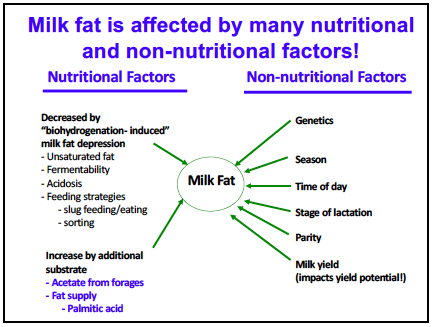Milk Fat: Keep Up with Genetic Potential
Milk Fat:
Keep Up with Genetic Potential
Milk fat remains “where it’s at” for dairy profitability. One example: Butter prices mounting a two-year upswing since the lows of 2020.
Fortunately, notes Penn State’s Dr. Kevin Harvatine, milk fat synthesis in the cow responds to many factors that can modify milk fat yield in the short and long term. Yet the complex interaction of these factors challenges diet optimization.
“The cow is changing”
“Keep in mind that the cow is changing,” Harvatine says. “Her genetic potential for milk fat yield is significantly higher than that of her ancestors. Her progeny are likely to offer even greater yield potential.”
Back in 2010, there were no states in the U.S. with standardized fat yield for Holsteins greater than 4.00%, whereas in 2020, several states, including in the Northeast, rose above this threshold. Jersey milk fat yield followed a similar trend.
In Pennsylvania, Holstein milk fat yield rose more than 0.30% over the 10-year period. And increases were greater in several other states.
“Ghost of summer”
Recent Penn State research characterizes the strong seasonal rhythm to milk fat concentration and yield occurring across milk markets, herds, and cows (for example, Salfer et al.), which other researchers report extends to concentrations of certain fatty acids (< 16 C).
However, Harvatine cautions against “chasing the ghost of summer,” referring to diet changes to mitigate seasonal milk fat decline, while ignoring the “opportunity of winter,” when milk fat peaks and spring when milk yield peaks.
“Small decreases in milk yield can overwhelm increases in milk fat resulting in little or no improvement in milk income. For example, a 0.1 unit increase in milk fat can be entirely offset by a 2 lb. decrease in milk yield. When considering fat plus protein yield, a 0.1 unit increase in fat is offset by a 1.1 lb. decrease in milk yield.”
Diet-induced MFD
In balancing diets, Harvatine says, the nutritionist must manage the risk of diet-induced milk fat depression, even though minimizing that risk is likely to reduce energy intake and milk yield.
“High quality forages and stable rumen fermentation, through increased acetate supply, best support de novo synthesis of milk fat. Yet the cow also needs dietary fat for milk fat synthesis. So although a specific dietary fat requirement does not exist, the nutritionist can consider all sources and the impact of individual fatty acids both in the rumen and downstream.
Last week, Harvatine addressed “Key takeaways from NASEM lipids” at Penn State 2022 Dairy Nutrition Workshop.
Questions?
Email FeedInsight 4Dairy

